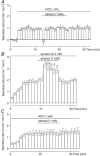Ethanol induces fluid hypersecretion from guinea-pig pancreatic duct cells
- PMID: 12847207
- PMCID: PMC2343300
- DOI: 10.1113/jphysiol.2003.048827
Ethanol induces fluid hypersecretion from guinea-pig pancreatic duct cells
Abstract
Ethanol is the leading cause of pancreatitis; however, its cellular effects are poorly understood. We examined the direct effects of ethanol in the concentration range 0.1-30 mM, i.e. relevant to usual levels of drinking, on fluid secretion from guinea-pig pancreatic duct cells. Fluid secretion was continuously measured by monitoring the luminal volume of interlobular duct segments isolated from the guinea-pig pancreas. [Ca2+]i was estimated by microfluorometry in duct cells loaded with fura-2. Ethanol at 0.3-30 mM significantly augmented fluid secretion stimulated by physiological (1 pM) or pharmacological (1 nM) concentrations of secretin. It augmented dibutyryl cAMP-stimulated fluid secretion but failed to affect spontaneous or acethylcholine-stimulated secretion. Ethanol at 1 mM shifted the secretin concentration-fluid secretion response curve upwards and raised the maximal secretory response significantly by 41%. In secretin-stimulated ducts, 1 mM ethanol induced a transient increase in [Ca2+]i that was dependent on the presence of extracellular Ca2+. Ethanol failed to augment secretin-stimulated secretion from ducts pretreated with an intracellular Ca2+ buffer (BAPTA) or a protein kinase A inhibitor (H89). In conclusion, low concentrations of ethanol directly augment pancreatic ductal fluid secretion stimulated by physiological and pharmacological concentrations of secretin, and this appears to be mediated by the activation of both the intracellular cAMP pathway and Ca2+ mobilization.
Figures






Similar articles
-
5-hydroxytryptamine strongly inhibits fluid secretion in guinea pig pancreatic duct cells.J Clin Invest. 2001 Sep;108(5):749-56. doi: 10.1172/JCI12312. J Clin Invest. 2001. PMID: 11544281 Free PMC article.
-
Caffeine Inhibits Fluid Secretion by Interlobular Ducts From Guinea Pig Pancreas.Pancreas. 2017 Apr;46(4):549-556. doi: 10.1097/MPA.0000000000000782. Pancreas. 2017. PMID: 28196026
-
Dual effects of n-alcohols on fluid secretion from guinea pig pancreatic ducts.Am J Physiol Cell Physiol. 2005 Jun;288(6):C1431-9. doi: 10.1152/ajpcell.00373.2004. Epub 2005 Jan 19. Am J Physiol Cell Physiol. 2005. PMID: 15659715
-
Physiology and pathophysiology of bicarbonate secretion by pancreatic duct epithelium.Nagoya J Med Sci. 2012 Feb;74(1-2):1-18. Nagoya J Med Sci. 2012. PMID: 22515107 Free PMC article. Review.
-
Secretin-dependent HCO3- secretion from pancreas and liver.J Intern Med Suppl. 1990;732:47-51. J Intern Med Suppl. 1990. PMID: 2200415 Review.
Cited by
-
TDP-43 regulates early-phase insulin secretion via CaV1.2-mediated exocytosis in islets.J Clin Invest. 2019 Jul 29;129(9):3578-3593. doi: 10.1172/JCI124481. eCollection 2019 Jul 29. J Clin Invest. 2019. PMID: 31355778 Free PMC article.
-
Pathogenic mechanisms of acute pancreatitis.Curr Opin Gastroenterol. 2012 Sep;28(5):507-15. doi: 10.1097/MOG.0b013e3283567f52. Curr Opin Gastroenterol. 2012. PMID: 22885948 Free PMC article. Review.
-
Apoptotic damage of pancreatic ductal epithelia by alcohol and its rescue by an antioxidant.PLoS One. 2013 Nov 14;8(11):e81893. doi: 10.1371/journal.pone.0081893. eCollection 2013. PLoS One. 2013. PMID: 24244749 Free PMC article.
-
Molecular mechanisms of pancreatic injury.Curr Opin Gastroenterol. 2011 Sep;27(5):444-51. doi: 10.1097/MOG.0b013e328349e346. Curr Opin Gastroenterol. 2011. PMID: 21844752 Free PMC article. Review.
-
Trypsin reduces pancreatic ductal bicarbonate secretion by inhibiting CFTR Cl⁻ channels and luminal anion exchangers.Gastroenterology. 2011 Dec;141(6):2228-2239.e6. doi: 10.1053/j.gastro.2011.08.039. Epub 2011 Sep 3. Gastroenterology. 2011. PMID: 21893120 Free PMC article.
References
-
- Benham CD, Davis JB, Randall AD. Vanilloid and TRP channels: a family of lipid-gated cation channels. Neuropharmacology. 2002;42:873–888. - PubMed
-
- Case RM, Argent BE. Pancreatic duct cell secretion: control and mechanisms of transport. In: Go VLW, Di Magno EP, Gardner JD, Labenthal E, Reher HA, Scheele GA, editors. The Pancreas: Biology, Pathobiology and Disease. 2. New York: Blackwell Science Inc; 1993. pp. 301–350.
-
- Chang TM, Chey WY. Radioimmunoassay of secretin; a critical review and current status. Dig Dis Sci. 1980;25:529–552. - PubMed
Publication types
MeSH terms
Substances
LinkOut - more resources
Full Text Sources
Miscellaneous

